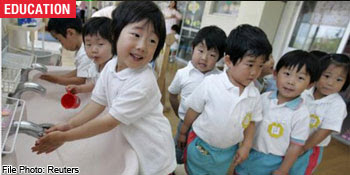China, Malaysia, Singapore, Taiwan and Hong Kong are some countries which preschools emphasize a lot on academic achievement. However, there are a lot of schools and education system in other countries which inspire me. When I see how they operate, they remind me a lot of the Montessori philosophy.
I just came across an article on Japanese preschool. A China mom was shocked over the preschool system in Kyoto when she sent her daughter there. The article stated 12 things that stunned her. A smile went across my face when I was reading it. What she wrote has clearly reflected the difference between the Chinese and Japanese education system. The Japanese system advocates independence, bravery, inner and outer strength of a child. The Japanese moms neither help their young child to carry bags nor change clothes. As a result, the Japanese children are all cheerful little angels with smiles on their faces at all times. (To check out this interesting article, click here.)

Why is that so? INDEPENDENCE leads to SELF-ESTEEM. Remember I mentioned this in my "Are Practical Life activities so important?" blog?
In addition, there are forest kindergartens in Germany, Switzerland, Sco tland, England and the USA, operating in woodland teaching children from 3 to 6 years old. The children at the age of 4 are allowed to use a knife without supervision. We see freedom within limitation here. The children are well aware of the consequence of misusing a knife, hence they are extra careful. Independence! Children learn academic subjects through activities in nature. These children can ease through their primary school very well after they have left the forest kindergarten, because they are more coordinated and willing to work out solutions to problems on their own. Bravo!
tland, England and the USA, operating in woodland teaching children from 3 to 6 years old. The children at the age of 4 are allowed to use a knife without supervision. We see freedom within limitation here. The children are well aware of the consequence of misusing a knife, hence they are extra careful. Independence! Children learn academic subjects through activities in nature. These children can ease through their primary school very well after they have left the forest kindergarten, because they are more coordinated and willing to work out solutions to problems on their own. Bravo!
 tland, England and the USA, operating in woodland teaching children from 3 to 6 years old. The children at the age of 4 are allowed to use a knife without supervision. We see freedom within limitation here. The children are well aware of the consequence of misusing a knife, hence they are extra careful. Independence! Children learn academic subjects through activities in nature. These children can ease through their primary school very well after they have left the forest kindergarten, because they are more coordinated and willing to work out solutions to problems on their own. Bravo!
tland, England and the USA, operating in woodland teaching children from 3 to 6 years old. The children at the age of 4 are allowed to use a knife without supervision. We see freedom within limitation here. The children are well aware of the consequence of misusing a knife, hence they are extra careful. Independence! Children learn academic subjects through activities in nature. These children can ease through their primary school very well after they have left the forest kindergarten, because they are more coordinated and willing to work out solutions to problems on their own. Bravo!
So, are we doing too much for our children which indirectly impede their development, especially in independence? Many children have "kakak" doing everything for them at home. The children may start to wonder, "Am I incapable of accomplishing the task? Kakak and other adults are more capable." This may lower the self-esteem of a child, which indirectly discourages her to learn in all aspects.
I have seen this happening a lot in the past few years of teaching. Some parents are willing to take my advice and start involving their children in household chores. I see a great difference after a child has become more independent. She is usually confident about herself and is happy and willing to take up challenge to learn new things.
Related Blog:
1. Are Practical Life activiities so important?
Related Links/ Articles:
1. Japanese Preschool: 12 things that stun a Chinese mom.
2. Forest Kindergarten
Related Blog:
1. Are Practical Life activiities so important?
Related Links/ Articles:
1. Japanese Preschool: 12 things that stun a Chinese mom.
2. Forest Kindergarten

